Sepilok Orangutan Rehab Centre: Rescuing Borneo's Orangutans
Only 25km outside the city of Sandakan in Borneo's north east, likes Sepilok Orangutan Rehabilitation Centre. They are doing great work with rescuing and rehabilitating (where possible) Orangutans that have been displaced due to land clearing or proximity to new human settlements.
A visit the the centre is a must do for anyone visiting Malaysian Borneo. It will help to restore your faith in humanity and of course your entry fees help maintain the centre and the staff they employ.
Another benefit is enjoying the Orangutans and other monkeys you see. They are so human like and its hard not to be touched emotionally.
About Sepilok Orangutan Rehabiliation Centre
The Sepilok Orangutan Rehabilitation Centre, nestled in the lush rainforests of Sabah, Borneo, stands as a beacon of hope for the conservation of orangutans, one of the most enchanting and endangered species on our planet.
Established in 1964, the centre spans across 43 square kilometers and is dedicated to the rehabilitation of orphaned and injured orangutans. The centre provides them with a safe haven to heal and learn vital survival skills before being released back into the wild.
Visitors to the centre have the unique opportunity to witness these incredible creatures up close, observing their playful antics and awe-inspiring agility in a natural setting.
The centre not only plays a crucial role in the preservation of orangutans but also serves as an educational hub, raising awareness about the importance of wildlife conservation and the threats that these primates face in the wild.
Through its tireless efforts, the Sepilok Orangutan Rehabilitation Centre continues to make significant strides in the fight to protect orangutans and their habitat, ensuring that future generations have the chance to experience the magic of these remarkable animals.
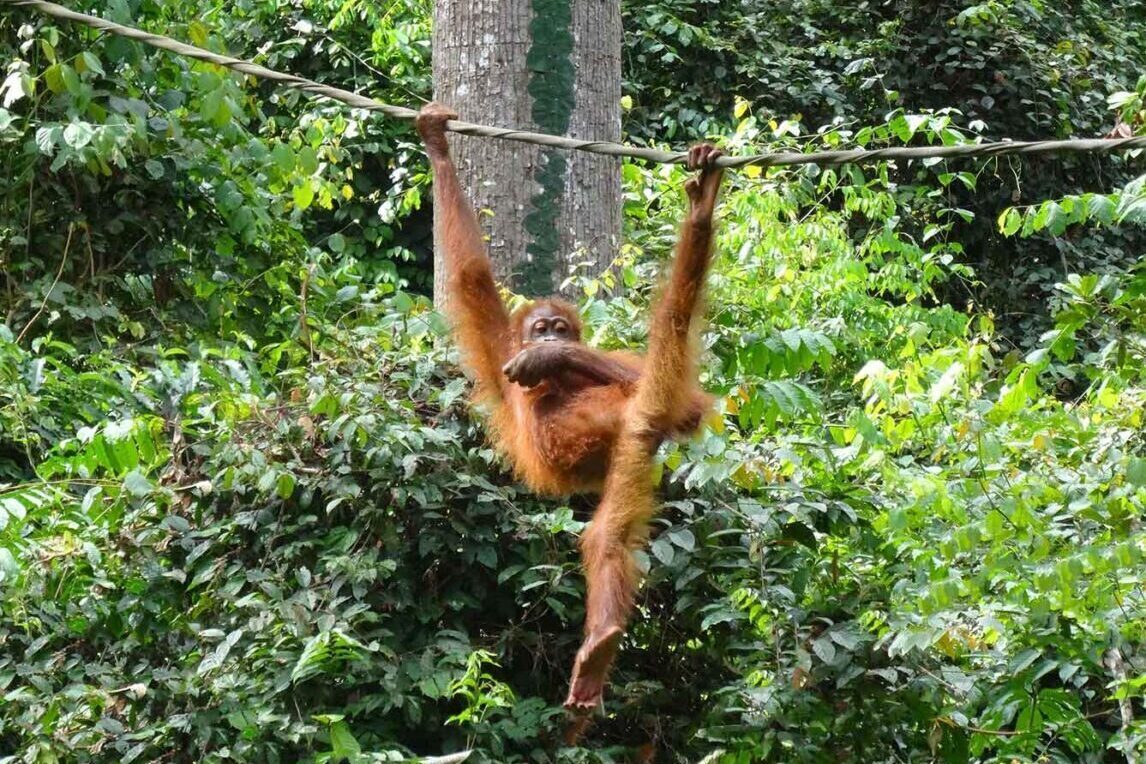
I never expect too much from animal sanctuary's. I know I'm cynical and I really struggle with animals in cages or not roaming free, however, I'm not that cynical that I will make a judgement without actually checking out those that seem to be OK.
Visiting the Orangutan Rehabilitation Centre in Sepilok, was the third time in a week that I was very pleasantly surprised with the animal rehab centers here in Borneo.
We were treated to amazing weather the day we did the Orangutan Centre which of course is never a bad thing, however it was an especially spectacular day weather wise.
Visit the Orangutan Nursery
We headed first off to the nursery section which is where they care for the orphaned baby orangutans and this is where I expected to be pretty upset. Despite my reservations, it's a great facility and their focus is on bringing up the infants only for the purpose of being able to join the balance of the population out in the trees and not for the purpose of being an orangutan on display.
Human interaction is minimal and decreases as the infant gets older to maintain the focus on turning out self sufficient animals that could survive in the wild. I was actually impressed which is hard to do.
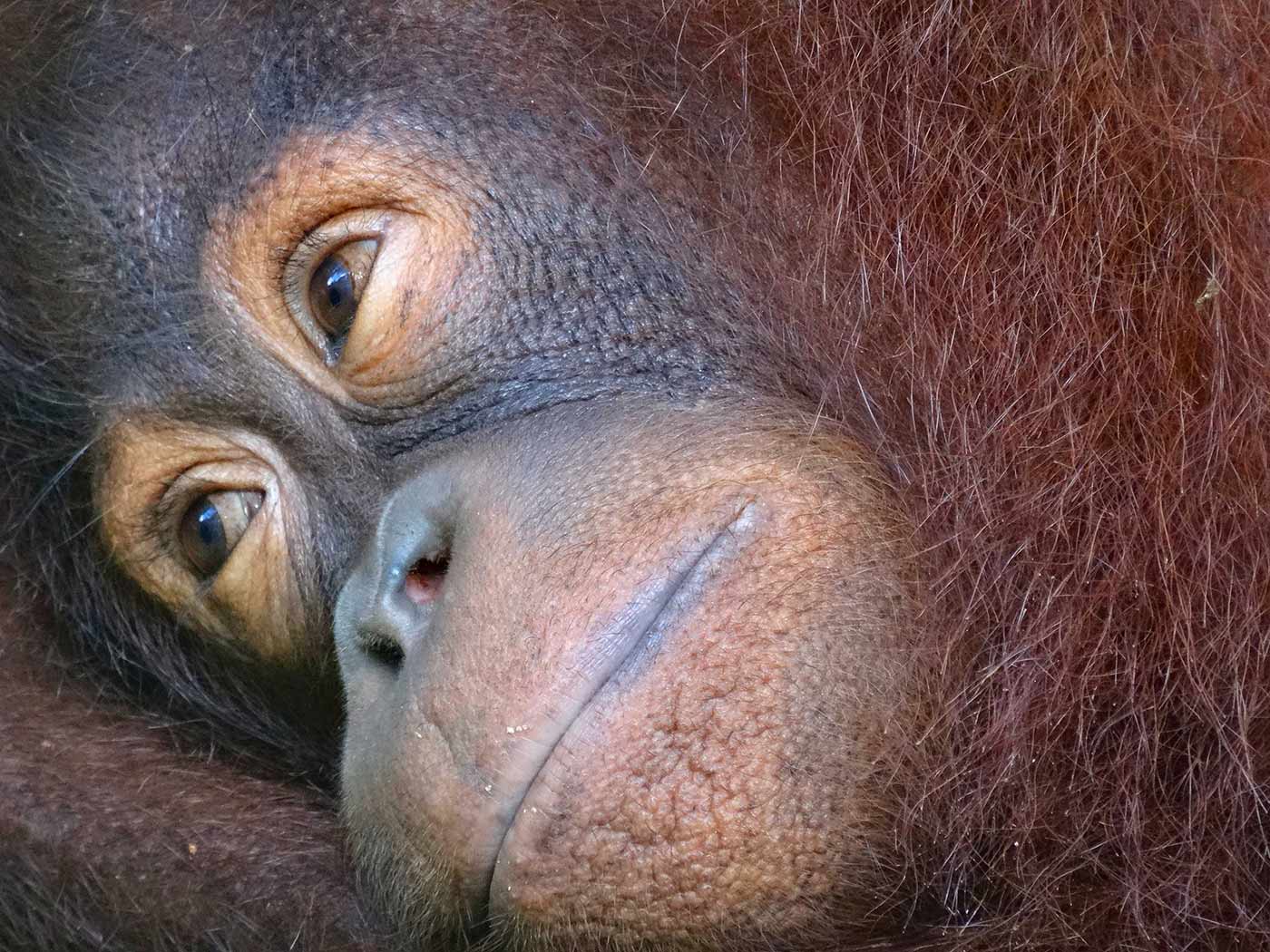
Watching the Orangutans feeding
Leaving the nursery, our guide walked us down to the stations where you can see the older Orangutans coming in for feeding. We were pre-warned that as it was fruit season the chances of seeing too many was very slim. We met people in the carpark who had come back today as they had seen only one Orangutan the previous day.
While I was prepared to be disappointed I was actually secretly a bit pleased. That meant that the Orangutans weren't reliant on the feeding schedules which made my day. I am always nervous that while their lifestyle is vastly improved these creatures just end up in a bigger more expansive zoo. I was delighted that they don't. More so I was delighted that they fend for themselves and aren't at all reliant on the feeding times.
The stations are set back into the forest and you are probably 10 metres from them I guess. They have rigged these heavy duty wires everywhere for the Orangutans to swing on which is awesome and of course it means that you see the wires moving sometimes 20 minutes before you see the Orangutan.
We were very lucky indeed. 3 came down for the morning session and because our ticket works for the whole day we went back in the afternoon and saw even more, along with a mother and baby.
I don't know whether its because they are so human like or if they are just so damn cute, but its hard to to leave not grinning like a tool. They are amazing creatures and the centre is doing good work.
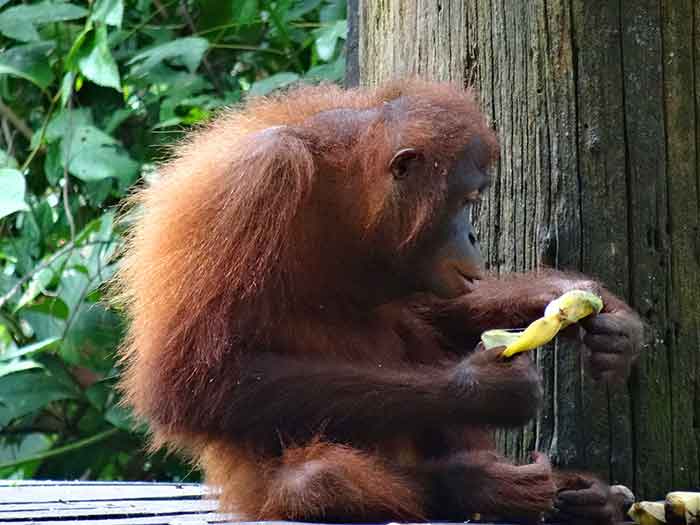
What's the main risk to the Orangutans?
Like in so many places in the world, Borneo's native animal habitat is being destroyed at an alarming rate.
Disconcertingly in Borneo (as in other parts of mainland Malaysia) the land is being bulldozed for Palm Oil plantations. It's not just that they are new plantations either, it's that these plantations are often the source of “certified sustainable” grown palm oil.
Malaysia's economy has been driven by bribes since the beginning of time and this practice is still in place and widely used. Certificates for sustainable farms can be purchased the same as almost anything else can be purchased in Malaysia. So even purchasing products that are marked as sustainably grown palm oil isn't necessarily helping.
That palm oil has got a very real chance of having come from a farm that was made from bulldozed native forest.
The other really disturbing thing is that these farms are often run from foreign investment, so the value of eco tourism has no effect on these corporations. They aren't from Borneo so they don't care if Borneo increases their income from tourism. You can't impress upon a foreign entity the value of replacing products with nature tourism if it's not their country.
What can you do?
The best thing you can do is educate yourself about what products actually contain palm oil and doing your best to avoid them.
You can also donate through WWF or a similar charity, or directly to the Orangutan Appeal.
Look for the RSPO label
This certification is taken very seriously and isn't easy to get. There is a lot involved in obtaining this certification which includes inspections, assessment of past and ongoing processes with revisions constantly taking place.
Check out the RSPO website for more info
Learn What Products Have Palm Oil
Seriously limit your use of Palm Oil. The plantations are taking over wildlife habitats so fast in Malaysia and especially Borneo.
Check out this WWF page and see exactly how much Palm Oil you are consuming. It is in so many products and while it can be hard to eliminate it completely, you should be able to purchase products with the RSPO certification for anything you can't do without.
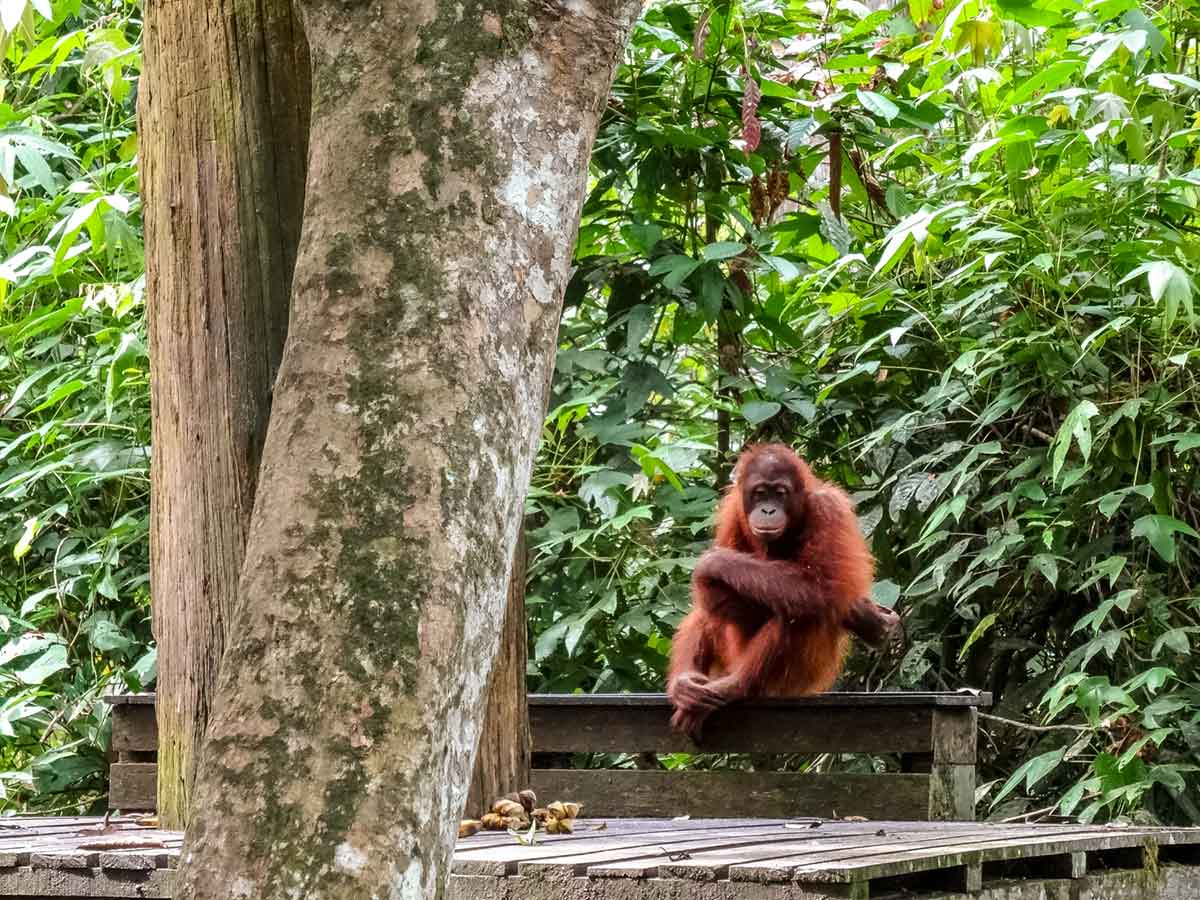
How To Visit The Sepilok Orangutan Rehabilitation Centre
I would recommend staying at least one night right next to the park. I stayed at Nature Lodge Sepilok and it was great. The rooms were clean and there is a restaurant so you don't need to find somewhere to eat.
The reason I recommend this is that if you can just walk back to the park for the afternoon feeding, if there aren't too many Orangutans around in the morning, you have another chance.
This was the best thing about staying close. As your ticket works for the entire day you can leave and come back. It also gave me a chance to visit the Sun Bear Rehab centre which is right next door almost.
If you have your own car, you can just drive out from Sandakan and spend the day. Alternatively you can get a tour from Sandakan and even from Kota Kinabalu. Viator has heaps of options so check out some below.
Tour Options for Visiting Sepilok Orangutan Sanctuary
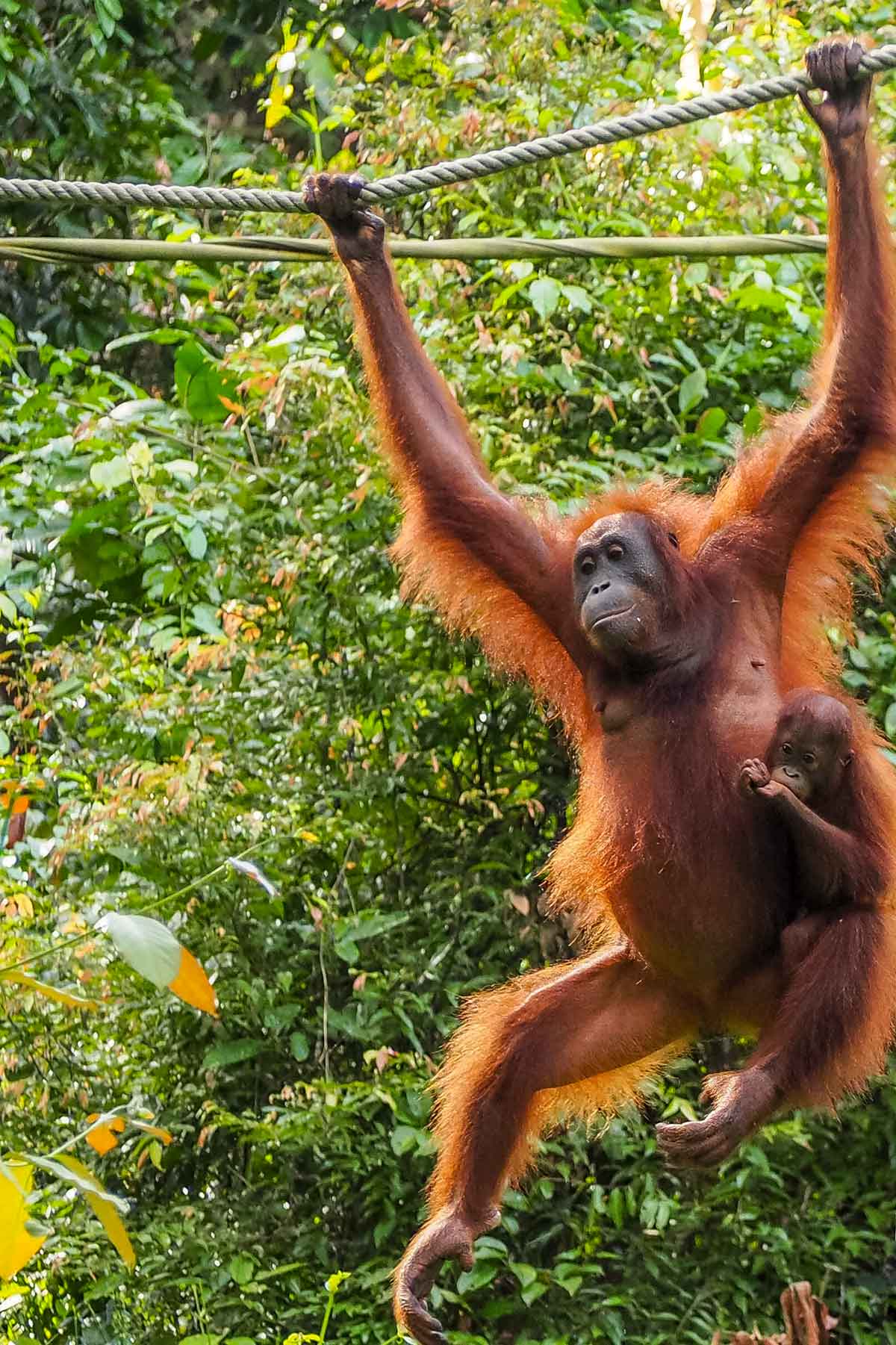
Tickets and Times for Sepilok Orangutan Rehabilition Centre
Tickets to Sepilok
Tickets are available from the ticket booth between 9am and 11am. The booth is open again from 2pm to 3:30pm as well.
Tickets for foreign travellers are currently 30RM. The ticket allows you to visit both the morning and afternoon feeding sessions so they are great value.
At this time, you can't pre-purchase tickets.
Sepilok Orangutan Rehab Centre Opening times
The centre is open daily from 9am to 4pm every day of the year.
The feeding platform is open from 9-12 and 2-4pm, however Fridays the morning session finishes at 11am.
The Orangutan nursery is open the same times as the feeding platforms.
Orangutan Feeding times
The orangutans are fed at the feeding platforms at 10am & 3pm daily. Please remember that while they do come down for the fruit they are fed, if its a plentiful spring season, sometimes they don't need the food on offer. With this in mind, you might not see as many Orangutans as you would like.
Photography In Sepilok
If you want to take a camera in to the rehab centre, you will need to pay RM10 for the privilege. If you have a zoom lens that is over 600mm the fee is RM1000. RM1000 is approximately $350 AUD!
Phone photography is fine, its just the larger camera's they ask you to pay for. There is no mention of personal or commercial photography, so I assumed that because I had paid the fee, I'm allowed to use the images I took.
There is a camera fee of RM10 (approximately £2) should you wish to take your camera to the feedings with you. Please note that cameras with over 600mm lens will incur a fee of RM1000 (approximately £180).

Meet Jenny, a passionate Australian travel blogger who has explored 103 countries to date. With over 30 years of travel experience, Jenny has a wealth of knowledge to share with her readers about the cultures, landscapes, and people she has encountered on her journeys. She's always battling unfashionably frizzy hair and you will never catch Jenny in anything but comfortable shoes. Learn more about Jenny and her travels.
